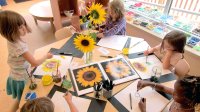Playful Inquiry for Elementary Students
Six suggestions for bringing a key idea from a Reggio Emilia–inspired school to your K–5 classroom.
Your content has been saved!
Go to My Saved Content.Stepping into a classroom at Opal School, a small public charter school in Portland, Oregon, is an invitation to wonder, play, and be provoked. Materials for tinkering, creating, and exploring are within easy reach so that children can make their thinking visible and discussable. Meanwhile, teachers document learning as it unfolds with audio recordings, photos, notes, and more.
Although Opal School can accommodate only 88 children in grades K–5 (and another 30-plus in a tuition-based preschool), the institution’s reach is much larger. Some 1,000 adult learners from around the world also connect annually for study tours, professional development, and other special events.
“From the beginning, our goal has been to strengthen public education by provoking fresh ideas concerning environments where creativity, curiosity, and the wonder of learning thrive,” explains Susan MacKay. She is director of teaching and learning at the Portland Children’s Museum, which operates Opal School in a unique partnership with Portland Public Schools.
Looking for fresh ideas to share with teachers heading into the new school year, I joined a sold-out crowd of 300 earlier this summer for a symposium called Play, the Arts, and Education for Democracy. The event drew attendees from across the U.S., including many returnees seeking a refresher in what Opal School calls playful inquiry.
From Italy to Oregon
Opal School was inspired in part by the renowned schools for young children in Reggio Emilia, Italy. This network of municipal preschools and nurseries was founded in post–World War II Italy to grow a new citizenry that would resist fascism. The Reggio philosophy values critical thinking, curiosity, and self-expression over rote learning or compliance.
Seven decades later, Reggio schools continue to attract visitors from around the world and have inspired a growing international network of like-minded schools and preschools. The North American Reggio Emilia Alliance includes individual schools and small networks like a consortium of preschools in West Los Angeles.
MacKay vividly recalls her first trip to Reggio Emilia with a cohort of Oregon educators back in 2000. “We were struck by the level of sophistication and the expressive capacity of very young children. Their creativity, use of materials, dialogue—it was such high-level work. We asked ourselves, what are the implications for American public education?”
Opal School opened a year later to investigate that question. It continues to be a place where teachers inquire alongside students and where educating for democracy is a daily goal. Matt Karlsen, associate director of the Museum Center for Learning, says that when visitors come to Opal School, they often react the same way MacKay and her colleagues responded in Reggio.
Ideas to Inspire
To bring more playful inquiry into your classroom this school year, consider these suggestions from the Opal School team.
Be welcoming: To create a welcoming culture where relationships will thrive, start finding out who your students are before you even meet them. MacKay says, “Where are your students coming from? Who are their families? What do they care most about? What resources will children bring with them? Prepare yourself to listen to who these particular children are when you meet them.”
Build connections: If your school has an established curriculum, think about how your students will connect to that content. “What’s going on in the world, in their neighborhood, in the news? What’s out there that will make connections between this body of information that adults say is important and their own lives?” MacKay asks.
Look for “long-distance local”: The classroom is an extremely local place, MacKay reminds us, “with its own cares, concerns, and dynamics. What are the things way out in the world that you know will connect with things this group of kids cares about?” Arguments about race or injustice might be flaring up halfway around the world—and also in your classroom or on the playground. “If you open the door, children are ready to talk about discomfort. Help children recognize these patterns and learn from them. When you can do that, you have brought the world into their local.”
Build question banks: Young children may need your help to find their way to interesting questions. “You may have to really listen to find out what children are curious about,” MacKay says. “You have to create environments for interesting questions to rise up.” Karlsen suggests creating a bank of open-ended questions “that you look forward to mulling over with the children. If the first question falls flat, you’ll have 80 more behind that.”
Document everything: Although it might sound challenging to document daily learning with photos, notes, journals, and audio recordings, MacKay can’t imagine working any other way. When documentation becomes a habit, it serves as a prompt to reflect. That habit is equally useful for teachers and students—as Karlsen explains, curious teachers lead to curious kids. Here’s a sequence of questions to consider daily:
- What do I think is going to happen?
- What actually happened?
- What might we do differently next time?
- What do we want to do tomorrow?
- What does this make you curious about?
Provide open-ended materials: Make materials inviting for children to use as tools for thinking, creating, and discussing. This doesn’t require a big budget, but it does involve thoughtful presentation. “It’s not just stuff in a box,” MacKay says. Seeds, leaves, and rocks gathered on nature walks “can be presented in a way that makes them very attractive. Kids want to go play with them.” The key is watching and listening to see how children interact with materials, what they say and do and make.
Learn more about opportunities to connect with Opal School during the 2017–18 school year.
